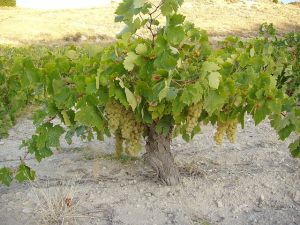The Airén grape is a white grape variety native to Spain. Despite its relative anonymity compared to more famous varietals like Chardonnay or Sauvignon Blanc, the Arién grape holds a significant place in the history of Spanish wine making and has an intriguing profile that contributes to its unique character.
Historical Roots
The Arién grape has deep historical roots in Spain, with its origins tracing back to the central regions of the Iberian Peninsula. Records suggest that the variety was cultivated as early as the 18th century. Over time, it became one of Spain’s most widely planted white grapes, primarily due to its adaptability and resilience. By the mid-20th century, it was considered the most widely grown grape variety in Spain, although its prominence has since waned with the rise of other varieties and changing wine production practices.
Geographic Distribution Airen vine in Spain (By Fabio Bartolomei – Self-photographed, CC BY 3.0, commons.wikimedia.org)
Arién thrives in the hot, dry climate of central Spain, particularly in regions such as La Mancha, Castilla-La Mancha, and parts of Madrid. Its adaptability to arid conditions and high yields make it an attractive choice for large-scale production. In La Mancha, the grape’s ability to withstand extreme temperatures and its prolific nature have cemented its status as a cornerstone of the local wine industry. The grape is also grown in other Spanish regions and has seen some plantings in Australia and South America, though its primary home remains in Spain.
Flavour Profile and Aromas
The
This Article was originally published on My Wine Pal





